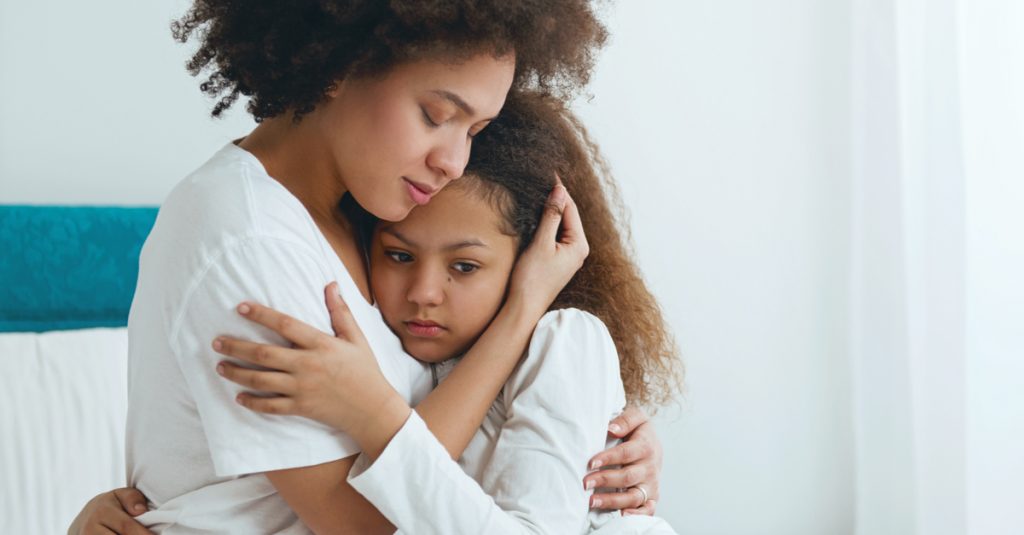
There is no pain like that of losing a loved one, especially at a young age. After such a tragic loss, small children often experience a whirlwind of emotions for quite some time. They’re tremendously saddened, distraught, angry, and can have a lot of unanswered questions. As parents, what do we need to tell them about death and how should we approach the conversation?
In a perfect world, we wouldn’t have to explain death to a child until they were old enough to really grasp the concept of this harsh fact of life. But in the living world that we are all a part of, there is death. A child’s first encounter with death might be that of a pet goldfish or even the family dog. This is a golden opportunity to explain to the child what it means when something, once alive, is no longer living.
There’s No One Right Way to Talk to Kids about Death
There are many ways in which to explain death and not one of them is better than the other. The explanation should be based on what you want to teach your child about the world around them and about your beliefs, whatever they are. The biological facts of death are the easy part and if that’s your approach, keep it simple. Keeping to the facts of how the body dies is an easy enough task to explain to a small child. If you don’t really understand it yourself, there are a lot of resources out there that can help.
Many parents begin teaching their child about the family’s belief system long before their first experience with death. Where we “go” and what happens to us, depending on those beliefs, could be added to the facts of what death is. Be open to questions; give answers that are truthful and align them with your family’s beliefs.
Expect Questions
While the child may not completely grasp why the fish died, what he knows for sure is that he misses his little pet. Encourage the child to grieve and talk about his pain. Don’t ever shame the child for any emotion they might be feeling and sharing with you. It’s during these conversations a parent can begin to introduce fond memories of the passed one, thus beginning the healing process. This all works well, in theory, for a pet. But what about when a loved one dies?
If there have been conversations in the past about death, the child may already understand their relative or friend is not returning. But if not, gently explain there are times in our lives when things happen which we just don’t understand. You can say that if it were left up to the deceased, they wouldn’t ever want to leave and never come back. Helping the child understand that the deceased loved them very much and didn’t want to leave them willfully may help the child know how special they are and that they did nothing to cause them to die or to “leave.”
A lingering illness of the relative or friend preceding their death affords the opportunity to speak to the child about the process and what it all means. But when a loved one dies of a sudden or unexpected death, using loving but factual terms when communicating with the child can help them grasp their loved one is not coming back. And assuring the child that, in time, the grief they are feeling will become less painful can make all the difference.
How to Help Your Child Move On
In the case when a child loses their mother or father, the living parent may choose to marry again, bringing in a new step parent. I believe that it’s the job of both parents (the new step parent and the biological parent) to introduce the idea of the new parent joining the family. Assure the child no one could ever replace the diseased, but also explain the new parent is now part of the family. Setting aside bonding time together can help the transition and build trust, further signifying their late parent will not be forgotten or replaced.
Keeping pictures and artifacts of the deceased on display within the home also shows their memory is being embraced by the new parent. With this door opened, the child may begin to share memories of the parent which helps build trust and create a relationship. A relationship that is new and special.
As a registered nurse, I have seen a lot of death. What I’ve learned is no matter how much one has prepared themselves or their children, you don’t really know how it’s going to feel until it happens. Sharing in the grief and anger with your children after a loss is key to ensuring a smoother transition into acceptance. Remember, everyone’s pain is different – but we all hurt. Helping your child sort out their pain can provide comfort during the hardest time of their life.
Read Next | Tips for Blending Families with Young Children
Like what you read? JOIN the Mommybites community to get the latest on FREE online classes, parenting advice, events, childcare listings, casting calls & raffles, and our Parents With Nannies Facebook group. SIGN UP NOW!
Tami Reeves
Tami Reeves is the author of Bleeding Hearts: A True Story of Alzheimer’s, Family, and the Other Woman. For more information, visit www.TamiReeves.com.
The views and opinions expressed on this blog are purely the blog contributor’s. Any product claim, statistic, quote or other representation about a product or service should be verified with the manufacturer or provider. Writers may have conflicts of interest, and their opinions are their own.



